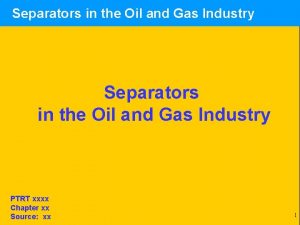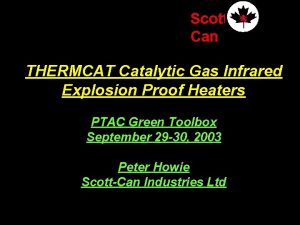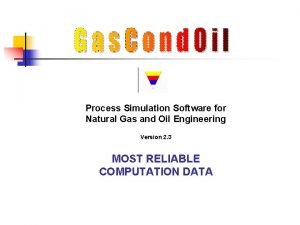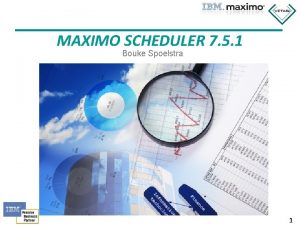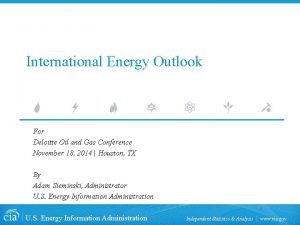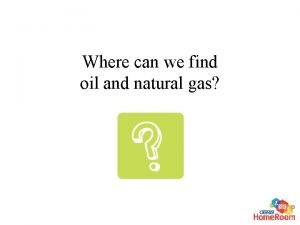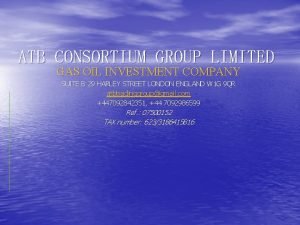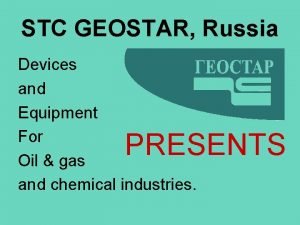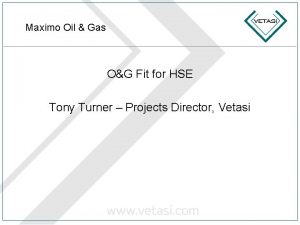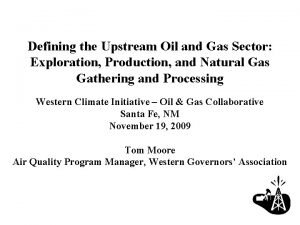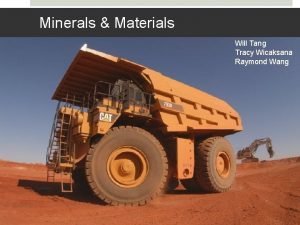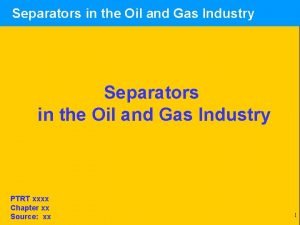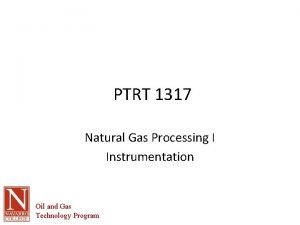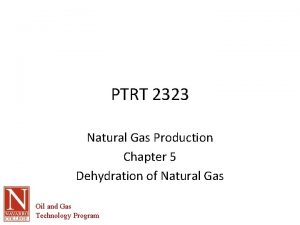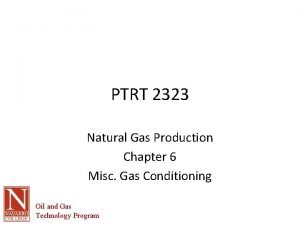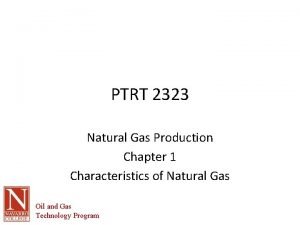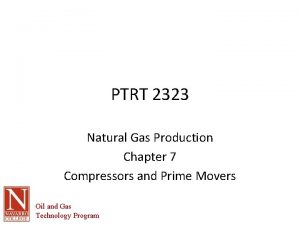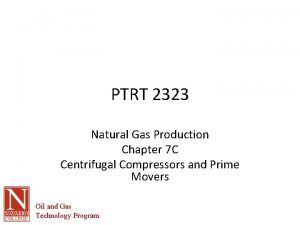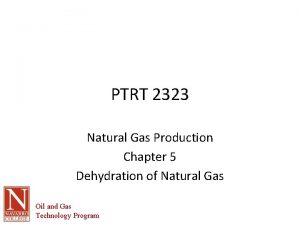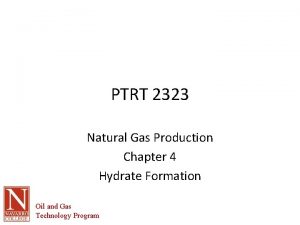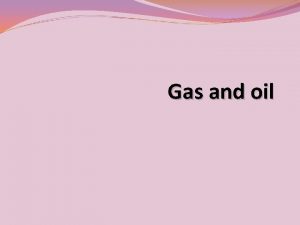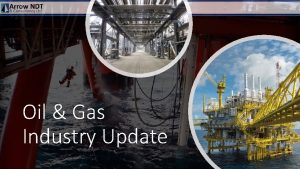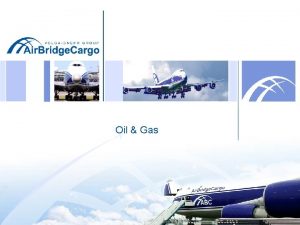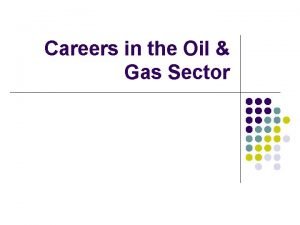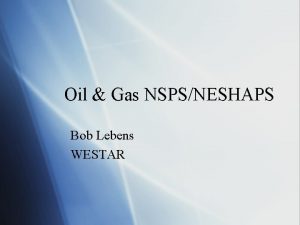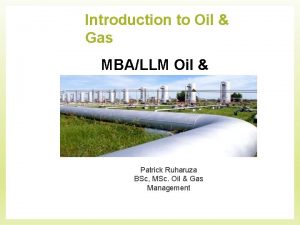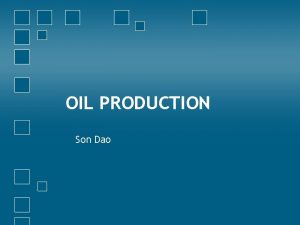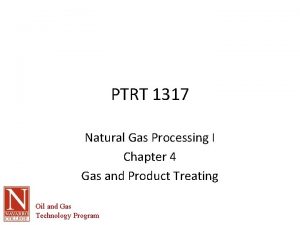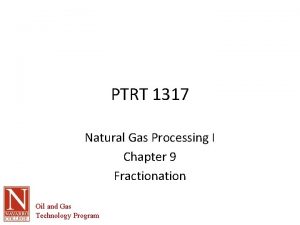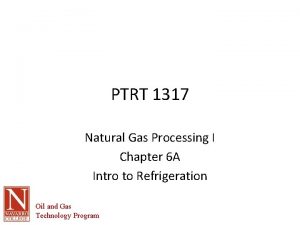Chapter 7 Managing Oil and Gas Production PTRT
























- Slides: 24

Chapter 7 Managing Oil and Gas Production PTRT 1301

Objectives �Start of production �Artificial lift �Well workover �Improved oil recovery �Gas production management overview

Overview �Once drilling is complete, focus is turned to well management to achieve cost effective, safe and environmentally sensitive extraction of crude oil and gas. �This chapter focuses on actions that optimize production from oil and gas wells, including maintenance, repair, and improved-recovery programs that help achieve this goal while extending the productive life of wells.

Production management � For production operation of a well the top of the wellbore is usually outfitted with a collection of valves and other components called a Christmas tree. It regulates pressure, flow and connects to pipeline for distribution. � If reservoir pressure remains high, the Christmas tree is sufficient for well production. If well pressure decreases, artificial lift methods can be employed to maintain economic production.

Artificial Lift-methods � Following initial production, two things happen: water (which is heavier than oil and much heavier than gas) begins to encroach into the formation; and reservoir pressure increases as the reservoir depletes. If no action is taken, then flow from the well will eventually stop. 1. The most common approach is to remove the Christmas tree and install a surface pump. The motor -driven sucker-rod pump (also called a pumpjack) is by far the most common.

Methods of artificial lift 2. Gas lift- a compressed gas is injected into the annulus between the casing and the tubing where it dissolves in the produced gas/water liquid and also forms bubbles. The dissolved gas and bubbles force the liquid up the tubing string, where the gas can be captured and recycled. 3. Installing a powered pump electric or hydraulic—at the bottom of the well tubing 4. pump hydraulic fluid down into the tubing string itself, allowing the produced gas and water to flow upward through he tubing/casing annulus to the surface.

Workover of a Well �Well workover-remedial action needed to maintain production from a well after months/years of production. �Prior to work-over, a well is shut in to stop production. Flow is killed by pumping brine, drilling mud, oil, or some other fluid down into the annulus, between the casing and the tubing, and back up the tubing string. �A BOP is usually installed while the tubing string and other downhole equipment are removed.

Workover steps �Removal of water or drilling mud (swabbing), done either right after a well is completed or later. �Repair or replacement of downhole pumps, valves, and packers �Installation of smaller-diameter tubing to boost flow rates �Removal of scale (salts, e. g. , calcium sulfate) or paraffin from tubing �Cleanout of loose sand from the bottom of wells drilled in sandstones �Repair of damaged tubing or casing or of the cement around the casing

Sidetrack wells and recompletion �A sidetrack well is drilled (if the original casing is damaged) using special drill tools—such as a whipstock, bent housing, or bent sub —are used to drill outward at an angle from the original well. The new wellbore is completed in the conventional manner, and drilling continues after a liner is set. �Recompletion- Done if operators determine that a particular pay zone is depleted. It is the completion of other pay zones below or above the original zone. Cement is used to seal off the original producing zone.

Offshore workovers � Use of a remotely operated vehicle (ROV) is often a better option.

Improved Oil Recovery � Primary production- Oil produced by the original pressure in a formation usually yields only about 30%– 35% of the oil in place. (For gas wells, primary production generally yields about 80% of the gas in place, so less attention is given to improved recovery. ) � A common technique often used first by operators to extract additional oil is called water flood, which can recover 5%-50% of the remaining oil. They introduce treated water through several injection wells placed in specific patterns around a producing well.

Enhanced oil recovery. �Enhanced oil recovery- Involve the introduction of substances not naturally found in a reservoir (gases, chemicals, or thermal energy) to boost reservoir pressure and sweep hydrocarbons from various parts of the reservoir towards the wellbores.

Enhanced oil recovery methods-cont. . � Gas injection- CO 2, N 2 or LPG is sent into the reservoir (gases that dissolve in the oil). The gas then pushes the fluid oil through the pores and cracks in the rock toward producing wells. This approach can often recover 35% of remaining oil. � Chemical injection method injects a slug of detergent (reduces surface tension of oil) into a depleted sandstone reservoir in separate batches, or slugs. The next slug—water thickened with polymers—pushes the micro-emulsion toward the producing wells. � Thermal recovery: used to make heavy oil remaining in a reservoir flow more easily. It includes methods like cyclic steam injection, Steamflood or steam drive and Steamassisted gravity drainage, Fireflood or in situ combustion

Thermal recovery-steam assisted � Steamflood or steam-drive technique is a thermal recovery method that pumps superheated steam into injection well to heat up oil to reduce its viscosity (resistance to flow). Recovers 25% to 65% of oil in place. � Steam-assisted gravity drainage (SAGD) has been used with great success in the tar-sands formations of Alberta. Steam is injected into an upper horizontal well to melt the tarlike bitumen, which flows downward into a lower horizontal well. The bitumen is then pumped from that lower well to the surface. By some estimates, SAGD can recover up to 60% of the oil in place.

Thermal recovery-in situ combustion � relatively shallow reservoirs, operators use a gas burner or other ignition source to set on fire the subsurface oil in one part of the formation. Recovers up to 40%.

Gas Production Management � Natural gas from a well that was drilled chiefly to extract oil is called associated gas—that is, the gas is associated with oil production. � If a well is drilled specifically for natural gas and yields little or no oil, then the gas produced is called nonassociated gas. � Condensate wells contain natural gas, as well as a � liquid hydrocarbon mixture (condensate) that is often separated from the natural gas either at the wellhead or during later processing of the gas.

Initial Gas. Treatment � About 75% of the raw natural gas in the US comes from underground reservoirs with little or no oil. This non-associated gas is cleaner (and therefore easier to process) than gas from wells that do contain oil. But regardless of the source, dirt, sand, and water vapor must be removed from the raw gas to prevent contamination and corrosion of equipment and pipelines. � A device called a wellhead separator performs initial cleanup, removing water, condensate and sediment. Dirt and sand are removed with filters or traps. Water vapor is typically removed by passing the gas through a desiccant material, such as silica gel or alumina (solid granules) or glycol (a liquid).

Gas Processing Operations � A network of small-diameter, low-pressure piping called a gathering system routes the gas from multiple (sometimes more than 100) wells to the gas plant. � When only hydrogen sulfide is present, natural gas is referred to as sour. Natural gas is described as sweet after the removal of hydrogen sulfide. � One common approach flows raw natural gas up through a tower while a spray of water mixed with a solvent is injected at the top. The solvent reacts with the two gases (carbon dioxide and hydrogen sulfide), and the solution is drained from the bottom of the tower for further processing.

Gas Processing Operations

Gas Processing Operations � A lattice structure of methane and water molecules, hydrate can plug pipelines, pressure regulators, and other equipment. � As the gas comes in contact with the cold oil, the heavier hydrocarbon gases condense into liquids and are trapped in the oil. The lighter hydrocarbon gases, such as methane and ethane, do not condense into liquid and flow out the top of the tower. About 85% of the propane, 40% of the ethane, and almost all of the butane and heavier hydrocarbons can be extracted using this absorption process.

Gas Processing Operations � Nitrogen can reduce the heating value of natural gas (because nitrogen does not burn). � The collective removal of carbon dioxide, hydrogen sulfide, and nitrogen is called upgrading, because the natural gas is made cleaner and will consequently burn hotter. � Natural gas is the main source of helium gas for industrial use in the United States. Extraction of helium gas is done after the nitrogen has been removed, using a complex distillation and purification process to isolate the helium from other gases. � water vapor-Besides affecting the heating value of the natural gas and contributing to corrosion, water can become part of a solid or slushlike compound, methane hydrate.

Environmental Issues �Both gas and oil extraction bring significant amounts of water to the surface and this produced water must be treated and/or disposed of in ways that minimize environmental impact. �In Oil/Gas wells, Produced water typically contains dissolved salts, as well as varying levels of hydrocarbons (oil and grease), chemical additives and propants, sediment, and even something called NORM—naturally occurring radioactive materials (e. g. , radium-226 or -228).

Environmental Issues �Methane is a potent greenhouse gas which can trap heat 20 times more effectively than carbon dioxide. �In 1993, the natural gas industry joined with EPA to launch the Natural Gas STAR Program to reduce methane emissions. Program data from EPA indicate that emissions were educed by more than 820 bcf from 1993 to 2008 (by 114 bcf in 2008 alone).

Well abandonment �After a well has been depleted to the point at which further economic recovery of oil or gas is not possible, it must be plugged and abandoned. This action is required by law, to prevent briny water from the well from polluting groundwater. -cut and extract the well casing for salvage purposes Install mechanical and cement plugs to eal off all high- pressure and permeable producing zones in the well. �When an offshore platform is abandoned, usually only the deck equipment is salvaged. The legs that held up the deck can be cut off at seabed level, and the entire rig can then be towed to shore for salvage or disposal.
 Jelaskan proses pembuatan multimedia content production
Jelaskan proses pembuatan multimedia content production Primary emulsion example
Primary emulsion example Types of separators in oil and gas industry
Types of separators in oil and gas industry Catalytic heater oil and gas
Catalytic heater oil and gas Process simulation software in oil and gas market
Process simulation software in oil and gas market [email protected]
[email protected] Maximo technician scheduling
Maximo technician scheduling Maximo oil and gas scheduler tutorial
Maximo oil and gas scheduler tutorial Madagascar oil and gas
Madagascar oil and gas Deloitte oil and gas
Deloitte oil and gas Hitachi vantara oil and gas
Hitachi vantara oil and gas Risk management case study oil and gas industry
Risk management case study oil and gas industry Drops oil and gas
Drops oil and gas Uses of oil and gas
Uses of oil and gas Atb oil and gas
Atb oil and gas Stc devices
Stc devices Osu oil and gas accounting conference
Osu oil and gas accounting conference Maximo scheduler run optimization
Maximo scheduler run optimization Maximo oil
Maximo oil Energy roles
Energy roles Oil and gas
Oil and gas Oil and gas revenue accounting basics
Oil and gas revenue accounting basics Darren prins
Darren prins Oil and gas company
Oil and gas company Standardization in oil and gas industry
Standardization in oil and gas industry


